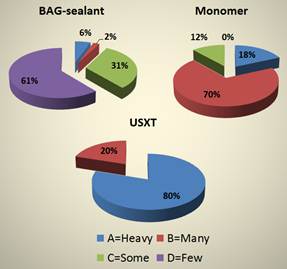The protection provided by dental pit and fissure sealants may be enhanced by using bioactive glass filler particles. These sealants may provide anti-microbial activity as well as inhibition of bacterial attachment to tooth/sealant surfaces.
Objective: We prepared novel tooth sealant materials containing bioactive glass (BAG) filler particles and assessed the ability of bacteria to colonize disks of this material.
Method: BAG with a composition of 81 wt% silica-11 wt% calcia-4 wt% phosphate-4 wt% flouride was synthesized in our lab. Ultraseal-XT resin without filler was supplied by the manufacturer (Ultradent Products, Inc. South Jordan, UT). BAG was incorporated into the resin (25 wt%) and provided handling properties similar to Ultraseal-XT(USXT) . Discs measuring 18.5mm by 0.5mm were prepared in a custom mold and light-cured. Discs of the polymerized monomer without filler, as well as Ultraseal XT discs were also prepared and served as controls. Discs (n=5 of each type) were immersed in a bacterial culture of sucrose-rich brain-heart infusion (BHI) media containing Streptococcus mutans strain #25175 and incubated at 37˚C, 5%CO2. The media was changed after two days, and samples were kept suspended in solution for a total of 96 hours. Discs were gently rinsed to remove non-adherent bacteria, fixed with glutaraldehyde, dehydrated, and gold sputter-coated for SEM examination. Micrographs were taken at ten predetermined locations on each disc and images were categorized by blinded observers into four groups, ranging from heavily covered to few bacteria adherent. The data were analyzed using logistic regression analysis (p=0.05).
Result: The sealant discs with BAG showed a significant decrease in bacterial adherence compared to UltraSeal XT plus and monomer alone.
Conclusion: The inclusion of anti-bacterial, ion-releasing BAG as a filler component results in fewer bacteria able to colonize the surface of the sealant itself which should enhance the effectiveness of these materials.
Keywords: Antimicrobial agents/inhibitors, Bacterial, Bioaactive glass, Biomaterials and Sealants
![[ Visit AADR's Website ]](images/banner.jpg)
